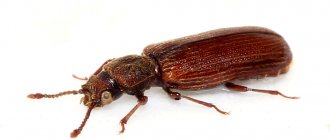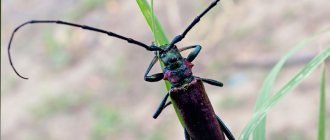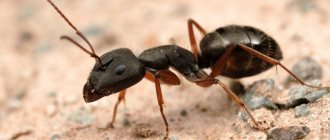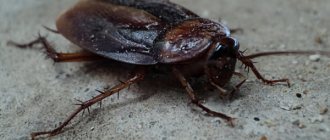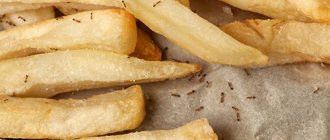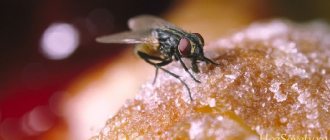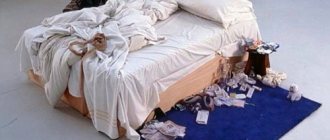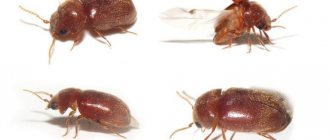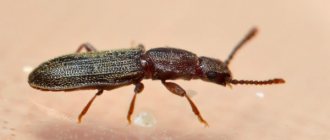Grinder beetles are insects from the order Coleoptera. The group is polymorphic, so it is difficult to find characteristics for all members of the family, but the general description is still the same for all.
The beetles are small in size, ranging from 1 to 10 millimeters; the most common are individuals 5 mm long. Their antennae are comb-shaped, consisting of several segments. The legs of the larvae are very developed, having claws with two scutes.
Beetles are found everywhere, the most common being the furniture borer, house borer and bread borer. Popularly, these insects are called woodborers, woodborers and woodborers, and the last of the woodborers is safe, but significantly harms supplies of other materials and food.
All beetles develop according to the same pattern and go through four stages. Females lay eggs in holes and crevices of dead wood. Then the larvae appear, they bite into the wood, eating out long, winding passages in it. Before the larvae transform into pupae, they move closer to the surface, the insect flies out and it is not the borer beetle that causes harm, but its larvae themselves. The larvae look like small worms, the body is white, and the head is dark brown.
The period of maturation of larvae from eggs is one to two weeks. They have very hard jaws; the larvae literally burrow into the wood. That part of the wood that has not had time to digest is thrown out; it represents drill flour, which clogs the passages. Larvae develop over a long period of time - from 12 months to several years. In some cases, this may be due to the rather late detection of this pest in a wooden house. Three weeks pass after pupation, and the cycle ends with the appearance of the beetle. This usually happens in early summer.
Grinders are ubiquitous. They destroy almost all deciduous and coniferous wood. Some of them make a sound similar to the ticking of a clock; this occurs during the mating period, when they hit their heads against the walls of the passage.
Beetles in the house - common types of borers
Let's take a closer look at some types of beetles that are quite common.
- Furniture grinder 2.5 - 5 mm long, dark brown, with stripes of dots on the elytra. The larvae are white and up to six millimeters long. The female lays eggs in darkened parts of furniture and wooden structures. Flight holes are oval, 1-2 mm in diameter. If conditions are favorable for the beetle, it can produce a couple of generations of offspring per year.
- The house grinder is black-brown in color, with golden spots on the back. Its length is 2.5 - 3 mm. The larvae are white, 7 mm long. The female lays eggs in flight holes and crevices. Coniferous wood located in places that are periodically moistened suffers from the effects of the larvae.
- The comb borer is 3-5 mm long and mainly affects deciduous wood. This species develops inside the tree for several generations, and after destruction, the beetles fly out en masse.
- The bread borer is a dangerous pest whose larvae eat mainly dry food and supplies of animal and plant origin.
Among the wood pests there are beetles of other families - bark beetles, longhorned beetles. For example, longhorned beetles and their larvae have an impressive size - up to 35 mm. Their larvae also gnaw holes in wood close to the surface.
The face of the enemy
The carpet beetle is a coleopteran insect. They are black or brown in color, with a body up to 12 mm long and elongated or round in shape. The bug is covered with hairs or scales.
This little parasite multiplies rapidly. And the larvae can live without food for five years.
In nature, skin beetles play the role of a recycler of dust, wool, feathers, and bones of dead animals. These are natural cleaners. Since humans are actively destroying their natural habitat, they have to move into apartments.
Uninvited guests enter houses mainly in the summer through open windows and vents. Also, household members can bring them themselves along with some things - books, carpets, furs, upholstered furniture. The parasite can also hide a newly purchased flower pot.
Carpet beetles are not at all harmless. They are harmful to human health. One bite of a small bug, and the household members have picked up some kind of viral infection or become infected with helminths. A bite can also cause an allergic reaction - unbearable itching in the bitten area.
The parasite must be removed as soon as possible. It is necessary to destroy not only the bugs themselves, but their caterpillars and all larvae.
And now we invite you to get to know the inhabitants of your kitchen better. Here we have collected photos of the 4 most common types of bugs and links to articles from Wikipedia about their characteristics and favorite food.
Below is a photo of the Suriname mucoed (Latin name of the mucoed: Oryzaephilus surinamensis). It is difficult to confuse the Surinamese mucous eater with anyone else due to its saw-toothed body.
Suriname mucoed
Next is a photo of the Flour Beetle or Flour Beetle (Latin name: Tenebrio molitor). By the way, mealworms are the larvae of the mealworm.
Flour beetle
The next photo shows the Bread Grinder, Carpet Beetle or Pharmacy Beetle in the company of their own kind (Latin name for the borer: Stegobium paniceum).
Bread grinder
And finally, a photo of rice weevils or elephants.
Weevils
Beetle grinder in the house - why it is dangerous
Carpenter beetles not only live in wooden structures, but also eat them. The ideal home for insects is wooden log houses. Lumber stored in stacks, especially logs and beams, are also attractive to them. Furniture can be eaten away by larvae to such an extent that at the slightest contact it crumbles into dust, the same applies to beams and ceilings.
The beetles are shy and are active mainly at night. It is not easy to see them, let alone catch them; when danger arises, the grinder pretends to be dead, so it is easy to mistake it for ordinary rubbish, and not at all for a living creature.
Smoke bombs
This method is suitable for large houses, warehouses, basements, and storage facilities. It is unacceptable for apartments due to its high toxicity (contains harmful substances) and specific action. When a smoke bomb operates, a huge amount of smoke is released, filling the entire available volume. In this regard, smoke detectors may go off, or neighbors may think that a fire has started.
Important! Precautions must be taken to prevent toxic gas from entering the body's respiratory tract.
What means to fight the grinder in the house
As mentioned earlier, it is not the beetles themselves that cause damage to wood, but their larvae. Therefore, if there is a beetle grinder, the fight should be aimed primarily at destroying the larvae.
Folk remedies in the fight against the grinder:
- The simplest remedy is Vaseline oil. You need to take it into a pipette or syringe and insert it into the holes, then fill them with wax, paraffin or cover them with window putty. The oil is odorless, non-flammable, and does not contain substances that threaten human health. This treatment is especially suitable for bedside tables and cabinets where food is stored. The procedure should be repeated after two weeks. If no new holes appear within a month, then the grinder beetle is defeated.
- A good way to fill the holes with a mixture of three parts turpentine and one part kerosene is to use naphthalene dissolved in gasoline (8g naphthalene, 90g gasoline). Apply the mixture with a brush.
- The fight against the borer is highly effective if you use hot air heating, the temperature should be high up to +60° C. Or, conversely, to destroy the larvae you will need to freeze the temperature below - 2° C, for two days or more.
- Equal parts black carbolic acid, tar and naphthalene. The resulting mixture is used to fill the holes and passages.
What are the dangers of small insects?
Check all cereals, flour, dried fruits, nuts. The bug can be in any product.
It is imperative to get rid of pests, since a black or brown bug can undermine any thing or piece of furniture in the house. Pests spoil books, clothes, carpets, etc. If you do not notice them in time, then gradually the population will increase many times over, while the intensity of the impact on things also increases. However, in this case, only the interior and clothing are damaged.
Small black bugs can also harm human health. Due to their small size, insects penetrate into food products: bread bin, jars, cabinets, bags.
They multiply in cereals and flour. The products of their vital activity remain here, which, when entering the human body, provoke allergies.
The reaction is manifested by redness, rash, and attacks of suffocation and coughing may occur. It all depends on the sensitivity of the body. Sometimes eating contaminated foods provokes symptoms similar to those of poisoning.
Bread affected by bread grinders
How to get rid of grinders in your home forever
How to remove woodworm beetles using special preparations? Chemicals and insecticides are recommended for severe damage to furniture and wooden elements by the grinder.
A good remedy for woodworms is copper sulfate. It is diluted and douched, using a syringe, injected into each hole, after cleaning the passages from shavings.
When working with any insecticide, you should follow safety precautions - rubber gloves, respirator, goggles. After carrying out work, you must thoroughly wash your entire body. You can fight the borer using insecticides that contain cypermethrin, lambda-cyhalothrin (Paragraph product), or organophosphorus compounds. With the latter option, the most effective are products containing malathion - Medilis-Malathion, Karbofos, Fufanon-Super, fenthion - Medilis-Super, Dobrokhim FOS, and, of course, chlorpyrifos - Averfos, Chlorpirimark, Sichlor and others. Fufanon will be very effective, since when applied to wood, according to the instructions, it is more convenient to apply it with a brush. Repeated treatment is carried out after two weeks, and it is advisable to carry it out even though the beetles will disappear the first time.
Extermination measures are effective from the beginning of May until about mid-June. Just at this time, bugs emerge from the pupae; after they have tasted the poisoned wood, their ability to reproduce is lost.
In July, until the newly hatched larvae have climbed too deep, you can use Prima-71 aerosol, chlorophos, dichlorvos, potassium dichromate. Before you begin processing, you need to clean the holes, as they are clogged with drill flour; this can be done with a thin wire. When the holes are filled with the preparation, they need to be covered (even with bread crumb) so that the liquid does not evaporate.
Beetles in small furniture or wooden objects are removed by fumigation. You need to find a suitable plastic bag, place the item there and treat it with dichlorvos.
To protect finished buildings, bathhouses and habitable houses, fumigation using phosphine is used. The method is good if there is significant damage to the wood and there is no access to individual elements. Fumigation outdoors will not have an effect, since the method involves processing indoors. An important feature of the method is the penetration of gas into all cracks, cavities and nooks, due to the highest penetrating ability. This will get rid of the grinder, no matter what stage it is in. Phosphine is a harmful substance, therefore, after processing and exposure, degassing, that is, ventilation, should be carried out.
Fumigation with insecticides using aerosol fog generators will not give a positive result; during fogation (fumigation), the drugs do not penetrate deep into the wood.
The latest achievement in the field of killing the wood beetle is microwave radiation. This method underlies the creation of a device that kills all living things in wooden structures. The radiation heats the wood and all the inhabitants inside to a destructive temperature. The procedure is simple. An installation that looks like a tin box is moved along the wall. You need to go around all surfaces, periodically turning on the device. At this time, the bugs and larvae are simply fried inside the structures.
Small Khrushchak
The small flour beetle has a brown or red body color and causes considerable damage to the food supply of a person in an apartment. It is widespread in Russia and Ukraine, where it often causes spoilage of grain in granaries, mills and other places where bulk products are stored.
The red-brown beetle is smaller in size (up to 3.6 mm), but it loves to settle in various food supplies in the apartment: flour, nuts, dried fruits and other plant fruits.
Unlike the large Khrushchak, the small one has wings and is able to fly. The males of such a flying insect have an abdomen rounded at the end and covered with hairs. In females, the tip of the body is bare; they are capable of laying up to 1 thousand eggs.
The larva of the small beetle has a flat shape and a length of up to 7 mm, the body color is yellow-brown (light or dark shades), the head is flattened. The body is covered with hairs and ends with 2 spines. The pupa is painted light yellow, and its body is shiny and completely naked. The development cycle of the flying black beetle is 20-120 days, and the growth rate directly depends on the amount of food and living conditions.
Preventive agents against wood-boring beetles
Bugs in the house are uninvited guests and their appearance is easier to prevent. Grinder larvae can be found in ornamental wood, door and window frames, furniture, floors, and other building elements.
- Wooden varnished and unpainted surfaces should be wiped with a mixture consisting of ten parts of turpentine, five parts of paraffin and wax, and three parts of creolin. Wax and paraffin are pre-melted.
- To prevent the appearance of woodworm, you need to maintain order in the house, take care of the furniture, and monitor temperature and humidity indicators. If low-value furniture is already infested with pests, it is better to burn it.
- Before building a house and buildings, it is necessary to check whether the lumber is infested with beetles; the boards should not have bark (pests live there). Infested wood can be safely used as firewood.
- In a private house, you should regularly inspect the rafters, walls, floors and ceilings, and at the slightest suspicion, take active action.
- Grinder beetles love high humidity, so it is better to dry the bathhouse using ventilation.
- The most common method to protect wood is to treat it with antiseptics (biocide composition Zhuk, Belinka, Antishashelin, Lignofix, Antizhuk, Wood Healer). The method is universal, as it allows you to prevent the appearance of bugs and fungus in one treatment. Complex treatment is recommended, three times with breaks of three days. When wetted, the antiseptic does not penetrate deep into the wood; the method is only good as preliminary protection of entire structures and lumber. When choosing an antiseptic, you should pay attention to its composition. It should include chlorophos, sodium fluoride, potassium dichromate, ammonium silicofluoride, dichlorvos.
If you find a borer beetle in your home, do not panic. If they have just appeared, there will be enough time to draw up an action plan and begin to follow it. The larva destroys wood for several years, and the means to combat wood-boring beetles have been tested for years and are reliable. And the easiest way is to get rid of pests once and for all with the help of a pest control service, which has effective methods of pest control and qualified specialists. This solution is the most reasonable and, perhaps, highly effective.
Risk area
Insect larvae require food. Some homes have more of it due to risk factors.
- Living a long-haired animal in the house. The wool that remains everywhere is an excellent breeding ground.
- Availability of book collections. Then you will have to take care of a safe binding for your treasures.
- The house is decorated with stuffed animals and birds. They will 100% be a hotbed for the spread of parasites.
- The cabinets are full of furs. If the bugs have not yet made themselves felt, it means that the house is damp and cool, the eggs are simply developing slowly.
Prevention measures
It is almost impossible to prevent the appearance of a beetle in the garden or in the house. When a house is being built from scratch, this can be done if all wooden structures are thoroughly impregnated with special solutions, and even then, over time they lose their effect. The main thing is to start fighting it in time, constantly checking wooden structures and trees in the garden for the presence of bark beetles. After detection, you need to immediately start fighting it. If it is not possible to completely destroy it, then at least reduce its number.
To protect trees in the garden from this pest you need to:
- It is better to treat the seedlings with special chemicals, such as “Lepitacid”, “Boverin”, “Bitoxibacillin” and others. These drugs help in the fight against bark beetles, as well as against ticks, bedbugs and butterflies. For these purposes, you can prepare the solution yourself. To do this, you need to take half a bucket of water and add to it 1 liter of liquid soap and a couple of glasses of carbolic acid. After this, prepare an active solution by diluting it with water in a ratio of 1 to 25. After this, all trees and seedlings in the garden are treated with this composition.
- It is equally important to choose a suitable site for planting seedlings. The soil should be sufficiently moist and nutritious. The soil around the trees should be well-groomed and fertilized. Be sure to dig up the ground and regularly remove damaged branches from trees.
- Annual preventative treatment of trees also gives good results. A simple mixture made from manure and slaked lime will do for this. They are taken in equal quantities, mixed and the trees are coated with this mixture. If a bark beetle is found on trees, this procedure is repeated several times.
- It is better to burn old leaves and bark, as well as other debris. Many pests, including the bark beetle, can overwinter in the garbage.
- You should not give pests a single chance by burning the remains of trees, especially after the crown has formed.
Errors during construction
Construction logs must be cleared of bark and subjected to special treatment. PROSEPT 42 or Prosept Ultra can serve as protection against bark beetle.
Propset concentrated products
Timely processing of wood will prevent the appearance and development of beetles.
When constructing a structure, it is necessary to ensure the continued safety of all wooden elements of the structure. Traditionally, the process of building a wooden house looks like this: the first layer is a vapor barrier, then insulation and wind protection, the construction is completed by a ventilation gap and finishing material (siding). Moisture rushing from inside the house to the outside encounters a vapor barrier, a dew point appears, and condensation occurs. Thus, good conditions have been created for the proliferation of bark beetles in a wooden house and the germination of fungal spores, although the destruction of the wood that has begun will not be visible for a long time.
The point of view of specialists in building physics and technologists working in wooden house construction is that a vapor barrier is not needed when insulating a wooden house. For a house that is constantly in use, vapor barrier is detrimental. Internal sources of moisture: people's breath, steam from cooking, moisture from watering house plants, and the bathroom increase humidity.
Medvedka
The mole cricket beetle in the garden is primarily dangerous for agricultural crops because during its movements in the soil (it leads an underground lifestyle), the pest actively gnaws the roots of plants that are in its path. Moreover, given the opportunity, he will never refuse to try the root vegetable or onion he likes more thoroughly, although the basis of his diet is insects and earthworms.
Mole cricket larvae (and this insect reproduces very quickly, laying literally hundreds of eggs) are similar to adult individuals, only smaller in size and during the growth process they feed on the same resources, increasing troubles in the garden beds.
Small holes in the beds and loose mounds of soil that appear in the places where the insect moves will tell you that a mole cricket is in the garden.
Measures to combat the mole cricket depend on its total number on the site and consist of placing various traps in the garden (containers with beer or honey, manure piles), pouring onion or garlic infusion into the mole cricket’s passages, planting plants with a pungent odor (marigolds, calendula), and also the use of insecticides (Grizzly, Medvegon, Medvetoks, Rembek, Terradox, etc.), which are placed in holes during planting of seedlings.
- How to deal with mole crickets - effective drugs and folk remedies
Don’t know how to get rid of mole crickets on your property? Our recipes will help you protect your garden crops from this underground pest.
